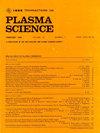Study on the Formation Mechanism of Soil Discharge Dark Space Under Negative DC Voltage
IF 1.3
4区 物理与天体物理
Q3 PHYSICS, FLUIDS & PLASMAS
引用次数: 0
Abstract
In recent years, there has been a notable increase in research activity concerning the remediation of soil using nonthermal plasmas (NTPs), as well as the study of discharges in soil. In examining the phenomenon of soil discharges under negative direct current (dc), researchers have identified the presence of discharge dark spaces. It is well established that the Faraday dark space is present under negative glow discharge. However, no instance of the discharge of dark space has been documented in soil discharges. It is noteworthy that, akin to the dark spaces observed in gas discharges, which occur exclusively in negative glow discharges, soil dark spaces are only discernible under negative dc discharges. Nevertheless, the underlying mechanism responsible for their formation remains elusive. In order to gain a deeper understanding of the mechanism of soil discharges and the formation of dark space regions, a new model of soil discharges is proposed in this study. Based on this model, we derived an expression for the extent of the dark space region. Furthermore, we explored the effect of the dark space region on soil discharge. These studies facilitate the development of technologies for the remediation of pollutants by soil discharge and provide new insights for further research on the potential mechanisms of soil discharge.直流负电压下土壤放电暗空间形成机理研究
近年来,利用非热等离子体修复土壤的研究以及对土壤中排放物的研究有了显著的增加。在研究负直流(dc)下土壤放电现象时,研究人员发现了放电暗空间的存在。在负辉光放电下,法拉第暗空间是存在的。然而,在土壤排放中没有记录到暗空间排放的实例。值得注意的是,类似于在气体放电中观察到的黑暗空间,它只发生在负辉光放电中,土壤黑暗空间只在负直流放电下可见。然而,它们形成的潜在机制仍然难以捉摸。为了更深入地了解土壤径流机制和暗空区的形成,本文提出了一种新的土壤径流模型。在此模型的基础上,我们推导出了暗空间区域范围的表达式。此外,我们还探讨了暗空区对土壤流量的影响。这些研究促进了土壤排放修复污染物技术的发展,并为进一步研究土壤排放的潜在机制提供了新的见解。
本文章由计算机程序翻译,如有差异,请以英文原文为准。
求助全文
约1分钟内获得全文
求助全文
来源期刊

IEEE Transactions on Plasma Science
物理-物理:流体与等离子体
CiteScore
3.00
自引率
20.00%
发文量
538
审稿时长
3.8 months
期刊介绍:
The scope covers all aspects of the theory and application of plasma science. It includes the following areas: magnetohydrodynamics; thermionics and plasma diodes; basic plasma phenomena; gaseous electronics; microwave/plasma interaction; electron, ion, and plasma sources; space plasmas; intense electron and ion beams; laser-plasma interactions; plasma diagnostics; plasma chemistry and processing; solid-state plasmas; plasma heating; plasma for controlled fusion research; high energy density plasmas; industrial/commercial applications of plasma physics; plasma waves and instabilities; and high power microwave and submillimeter wave generation.
 求助内容:
求助内容: 应助结果提醒方式:
应助结果提醒方式:


